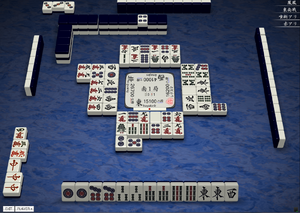Jigoku: Difference between revisions
m (→Wait strength) |
mNo edit summary |
||
| Line 15: | Line 15: | ||
==Background== | ==Background== | ||
The meaning of jigoku wait has undergone some changes over time. It commonly refers to any tanki wait as long as two copies of the winning tiles are visible, but it is also used to refer to the specific case where the winning tile is '''shaa''' (「西」 or '''west''') | The meaning of jigoku wait has undergone some changes over time. It commonly refers to any tanki wait as long as two copies of the winning tiles are visible, but it is also used to refer to the specific case where the winning tile is '''shaa''' (「西」 or '''west'''). It has also been used to refer to when the winning tile is any honor tile. | ||
Some people now started to use the term to refer to non-tanki waits where there is only one winning tile left. This usage is technically incorrect and misleading for the following: | Some people have now started to use the term to refer to non-tanki waits where there is only one winning tile left. This usage is technically incorrect and misleading for the following reasons: | ||
* The basic idea behind a jigoku wait is that the winning tile appears safe. When two of an honor tile had been discarded already, the 3rd honor tile is much safer to discard - the only way for it to be hit by [[ron]] is if someone had a tanki wait with the 4th copy | * The basic idea behind a jigoku wait is that the winning tile appears safe. When two of an honor tile had been discarded already, the 3rd honor tile is much safer to discard - the only way for it to be hit by [[ron]] is if someone had a tanki wait with the 4th copy, or with the rare and easy-to-detect [[kokushi musou]]. | ||
* However, when two of a number tile is discarded, the 3rd copy of said number tile is ''not'' much safer. In addition to tanki, an opponent can claim ron with the waits of [[ryanmen]], [[kanchan]], or [[penchan]]. | * However, when two of a number tile is discarded, the 3rd copy of said number tile is ''not'' much safer. In addition to tanki, an opponent can claim ron with the waits of [[ryanmen]], [[kanchan]], or [[penchan]]. | ||
* Therefore, some people still think that the term jigoku wait should only refer to honor tile tanki waits, not numbered tanki waits or other 1-tile left waits. | * Therefore, some people still think that the term jigoku wait should only refer to honor tile tanki waits, not numbered tanki waits or other 1-tile left waits. | ||
Revision as of 03:58, 29 June 2024
| Kanji | 地獄 |
|---|---|
| English | Hell wait |
| Fu | 2 fu |
| Tile types waiting | 1 sided wait |
| Tiles available | 1 tile |
| Pattern example |
|
| Tenhou.net example |
Jigoku 「地獄」, or "hell wait" in English, is a tanki wait where two of its three winning tiles are made unavailable (in the discard pile, in the dora indicator, etc.). This means that there is only one winning tile left.
Background
The meaning of jigoku wait has undergone some changes over time. It commonly refers to any tanki wait as long as two copies of the winning tiles are visible, but it is also used to refer to the specific case where the winning tile is shaa (「西」 or west). It has also been used to refer to when the winning tile is any honor tile.
Some people have now started to use the term to refer to non-tanki waits where there is only one winning tile left. This usage is technically incorrect and misleading for the following reasons:
- The basic idea behind a jigoku wait is that the winning tile appears safe. When two of an honor tile had been discarded already, the 3rd honor tile is much safer to discard - the only way for it to be hit by ron is if someone had a tanki wait with the 4th copy, or with the rare and easy-to-detect kokushi musou.
- However, when two of a number tile is discarded, the 3rd copy of said number tile is not much safer. In addition to tanki, an opponent can claim ron with the waits of ryanmen, kanchan, or penchan.
- Therefore, some people still think that the term jigoku wait should only refer to honor tile tanki waits, not numbered tanki waits or other 1-tile left waits.
Wait strength

In terms of pure acceptance, this is a very weak wait, as there's only one tile left to win off of. It is unreliable, since your lone tile could be in the dead wall. It is slow, since pairs are more common than sequences (thus, you'll often need to go out of the way to have a tanki wait).
However, because a jigoku wait is so poor, it can be used to trap players. A wait on an honor tile may actually end up being strong, as other players can view it as a safe tile and deal in. A jigoku tanki off a number tile that would be subject to suji or kabe is also more powerful.
Overall, while this wait is not great at winning, it is one of the better waits for trying to ron a player. Therefore, this wait is best used for emergency situations, such as being in last place at oorasu and other dire circumstances.
External links
| ||||||||||||||||||||||
